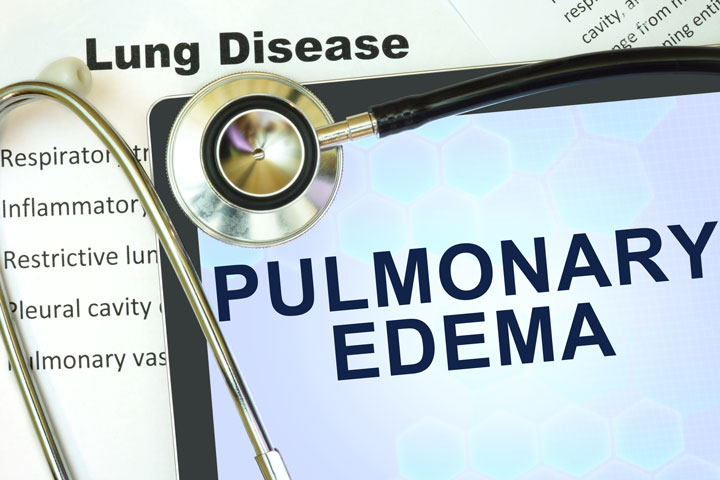An uncommon complication with serious consequences
Takeaways:
- Re-expansion pulmonary edema is a rare complication of pleural drainage with potentially fatal consequences.
- Nurses should suspect re-expansion pulmonary edema and initiate early management in patients with rapid onset cough, dyspnea, and hypoxia up to 24-hours after initiation of pleural drainage.
Thomas Wright*, a 42-year-old post-esophagectomy patient, is admitted to the medical unit from the emergency department (ED) for dyspnea and abdominal pain. X-rays in the ED reveal a stable, small left-sided pleural effusion and the development of a large right-sided pleural effusion several weeks after surgery. An outside report confirms ascites. The thoracic surgeon assesses Mr. Wright and consults interventional radiology (IR) to drain the effusion and ascites. A right-sided #14 French chest tube and #10 French peritoneal catheter are placed.
Initial assessment
When Mr. Wright arrives on the medical unit from IR, he tells the nurse he has chest discomfort and a cough. The nurse notes that the collection chamber is full at 2 liters. When the drainage system is replaced, the collection chamber quickly fills with nearly 1 liter of serous fluid. Mr. Wright’s vital signs are temperature 98.8° F (37.1° C), HR 120 bpm, RR 34 breaths per minute, BP 110/80 mmHg, and oxygen saturation 89% on 4 liters by nasal cannula. He has increased work of breathing, bilateral crackles, and sinus tachycardia on telemetry. The nurse notifies the nurse practitioner (NP).
On the scene
Mr. Wright reports increased chest pain, cough with pink-tinged, frothy sputum, and dyspnea. The NP immediately clamps the chest tube, and the nurse contacts the emergency response and respiratory therapy teams. The NP orders a stat ECG, ABG, and chest x-ray. The ECG reveals sinus tachycardia with a rate of 157 bpm. The ABG results are pH 7.26, PaCO2 31 mmHg, HCO3 14 mmol/L, PaO2 61 mmHg, base excess -12 mmol/L, and O2 88%. A chest x-ray shows a small, left pleural effusion, a right-sided chest tube, and re-expansion of the right lung with right lower lobe edema. A non-rebreather mask is applied, and Mr. Wright is transferred to the ICU to manage re-expansion pulmonary edema (REPE).
Outcome
The ICU team orders albumin for hypotension, bilevel positive airway pressure (BiPAP) for respiratory failure, and invasive hemodynamic monitoring lines. Mr. Wright receives vasopressors, endotracheal intubation, and mechanical ventilation support with positive end-expiratory pressure due to progressing cardiopulmonary failure. The ICU nurse monitors Mr. Wright closely.
When Mr. Wright’s cardiopulmonary status is stabilized, furosemide is administered to reduce edema. To prevent further REPE, 100 to 200 mL of pleural fluid are drained without externally applied suction every 2 hours for 48 hours.
Mr. Wright’s condition resolves within 48 hours. He’s transferred out of the ICU 2 days after extubation, requires several days of pleural fluid drainage before removing the chest drain, and is successfully discharged home.
About REPE
REPE is a rare complication after pleural drainage with rapid onset and varying severity. The potential exists for rapid respiratory failure with hypoxemia and alveolar infiltrates within 24 hours; however, REPE can occur as soon as 1 hour after pleural drainage. Risk factors for REPE are not clearly defined but include diabetes, large pneumothorax, pneumothorax greater than 1 week, rapid lung re-expansion, and low Eastern Cooperative Oncology Group Performance Status combined with drainage of pleural fluid >1.5 liters. REPE’s pathophysiology is unclear, and complex hydrostatic pressure and alveolar-capillary injury may contribute to vascular endothelial permeability. Learn about the treatment of REPE. (See Management of re-expansion pulmonary edema.) Collaboration is vital for patient survival.
Management of re-expansion pulmonary edema
During the early drainage process, nursing assessment findings critical to identify impending re-expansion pulmonary edema (REPE) include dyspnea, tachypnea, hypoxia, persistent cough, chest discomfort, and hemodynamic instability. Chest imaging, including x-ray and computed tomography demonstrating interstitial opacities, confirms the diagnosis. Supportive care includes oxygen therapy. Critical care management of REPE may include noninvasive ventilation (BiPAP or continuous positive airway pressure) or mechanical ventilation with positive end-expiratory therapy with low tidal volumes. Other interventions include diuretic therapy, inotropic therapy, and hemodynamic monitoring.
*Name is fictitious.
TaCharra Woodard is an acute care nurse practitioner in the division of thoracic and cardiovascular Surgery at The University of Texas M.D. Anderson Cancer Center in Houston.
References
Givertz MM. Noncardiogenic pulmonary edema. UpToDate. October 10, 2019. uptodate.com/contents/noncardiogenic-pulmonary-edema?search=flash%20pulmonary%20edema&source=search_result&selectedTitle=3~60&usage_type=default&display_rank=3
Kepka S, Lemaitre L, Marx T, Bilbault P, Desmettre T. A common gesture with a rare but potentially severe complication: Re-expansion pulmonary edema following chest tube drainage. Respir Med Case Rep. 2019;27:100838. doi:10.1016/j.rmcr.2019.100838
Lee SK, Hwang JJ, Lim MH, Son JH, Kim DH. Is severe re-expansion pulmonary edema still a lethal complication of closed thoracostomy or thoracic surgery? Ann Transl Med. 2019;7(5):98. doi:10.21037/atm.2019.01.55
Petiot A, Tawk S, Ghaye B. Re-expansion pulmonary oedema. Lancet. 2018;392(10146):507. doi:10.1016/S0140-6736(18)31722-7
Sagar AES, Landaeta MF, Adrianza AM, et al. Complications following symptom-limited thoracentesis using suction. Eur Respir J. 2020;56(5):1902356. doi:10.1183/13993003.02356-2019
Sarda S, Verma A, Jaiswal S, Sheikh WR. Reexpansion pulmonary edema: A rare complication of pneumothorax drainage. Turk J Emerg Med. 2020;20(4):196-8. doi:10.4103/2452-2473.297469
Wan Y-Y, Zhai C-C, Lin X-S, et al. Safety and complications of medical thoracoscopy in the management of pleural diseases. BMC Pulm Med. 2019;19(1):125. doi:10.1186/s12890-019-0888-5


















